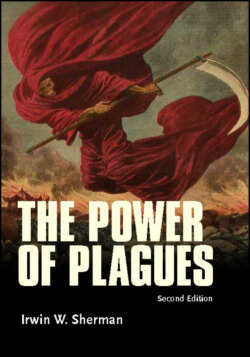Читать книгу The Power of Plagues - Irwin W. Sherman - Страница 31
The Cyprian Plague
ОглавлениеIn A.D. 250, Cyprian, the Christian archbishop of Carthage, described a disease that appeared to have originated in Ethiopia, then moved into Egypt, and eventually came to the Roman colonies of North Africa: vomiting, diarrhea, gangrene of the hands and feet, a burning fever, and a sore throat. The Cyprian plague became a pandemic, advancing quickly through direct person-to-person contact as well as by contaminated clothing. It is suspected that the disease was either smallpox or measles. Mortality is said to have been high, with the number of deaths exceeding those who survived. The plague of Cyprian lasted 16 years, causing panic among the people; those who fled to the surrounding countryside served as “seeds” for initiating fresh outbreaks. The land they left lay fallow. Despite this, the Roman Empire survived the devastation wrought by the Cyprian plague and was even able to overcome subsequent invasions by the Huns. But by 275 the Roman legions were forced to retreat from the Danube and the Rhine to the city of Rome. The situation was so precarious that the emperor decided to fortify Rome itself to protect against this plague. This also proved to be ineffectual.
The plague of Cyprian strengthened Christianity. Cyprian wrote:
Many of us are dying in this mortality, that is many of us are being free from the world. This mortality is a bane to Jews and pagans and enemies of Christ; to the servants of God it is a salutary departure. … Without any discrimination the just are dying with the unjust. … The just are called to refreshment, the unjust are carried off to torture; protection is more quickly given to the faithful; the punishment to the faithless. … This plague and pestilence which seems horrible and deadly, searches out the justice of each and every one.
This ability of Christianity to deal with the horrors and hardships of a plague made church doctrine an attractive alternative to the stoic and pagan philosophies, which were impersonal, uncompassionate, and ineffectual in explaining the randomness of death due to disease, and so served to strengthen its hold on the Roman peoples. The attraction of Christianity for the people of Rome not only altered their current religious and cultural practices but also influenced future social and political development.
St. Sebastian, often painted as a naked youth wearing a crown, tied to a tree and with his body pierced by arrows, is the patron saint of archers, athletes, and soldiers as well as the protector from plague (Fig. 3.4). His answers to prayers for protection from the plague, first in Rome and later in Milan (1575) and Lisbon (1599), were the cause for his elevation to sainthood. Documentation and myth along with the fate of St. Sebastian have been woven together in The Golden Legend, a text from the Middle Ages written in 1275 by the archbishop of Genoa, Jacobus de Voragine (1229-1298). It is written that Sebastian was born of a wealthy family in Narbonne in 257 and was educated in Milan. He became an officer in the Imperial Roman Army during the time of Emperor Diocletian (284-305) and was secretly converted to Christianity. Diocletian’s name is often associated with the last and the most terrible persecutions of the early Christian Church. During Diocletian’s persecutions, Sebastian visited his fellow Christians in the prisons, giving them food and comfort. But in 286, when Diocletian learned of his works in converting others to the faith, he ordered Sebastian to be shot to death by his archers. Sebastian was tied to a tree, shot with arrows, and left for dead. The arrows did not kill him, however, and a Christian widow, Irene, tended his wounds. Upon his recovery he continued to preach, and after he confronted the Emperor Diocletian to denounce his cruelty, the enraged emperor ordered that he be beaten to death by the blows of a club. The destructive effects of the plague (particularly bubonic plague) caused people to compare their being struck down by death to an attack by an army of archers, and so they prayed for salvation from a divine being; it is claimed that their prayers were answered by St. Sebastian. So, in time, Sebastian the saint of archers became the people’s protector from the plague.
Figure 3.4 St. Sebastian in a painting by Andrea Mategna (1490) in Ca d’ Oro, Venice , Courtesy of Wikiart.org
Over the next 3 centuries Rome slowly collapsed under pressure from the Germanic tribes (Goths and Vandals) as well as recurrent outbreaks of mysterious plagues such as that of Antonine, Cyprian, and others. Gradually, the Four Horsemen of the Apocolypse—Famine, Disease, War, and Death—led to a disintegration of the Roman Empire. And when the Germanic peoples moved into Italy and Gaul, crossed the Pyrenees into Spain, and even reached North Africa, they too became subject to this plague; by 480 the Vandals themselves were so sickly that they were unable to resist invasion by the Moors.
